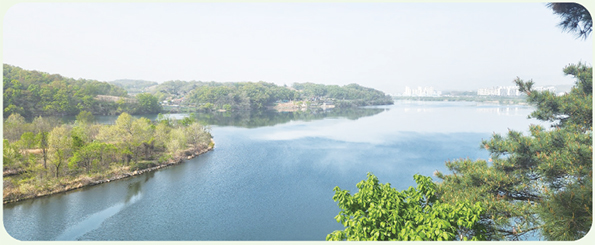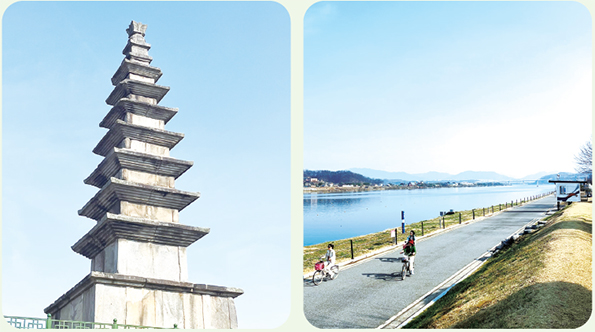The Chungbuk Times > Global > View
Relaxation found in Chungju City
力 215 龋 惯青老 : 2024.04.22

Chungju City, which is from the “Chung” in Chungcheongbuk-do, is a city in northern Chungcheong province, South Korea. It borders Jecheon City to the east, Eumseong County to the west, Goesan County and Mungyeong City to the south, Wonju City in Gangwon province, and Yeoju City in Gyeonggi province to the north. Due to the mountains lined up along the Sobaek Mountains to the southeast, the Namhan River (氧税) and Dalcheon Stream (庸艄) which passes through Chungju city, Chungju city is located in an inland basin rich in water resources, making it a historical hub since ancient times. Chungju city reconstructs nature-friendly spaces along with historical sites to provide resting places for citizens according to these geographical factors.
A CBT reporter visited Chungju city with the keyword “Relaxation” among Chungju City’s various tourist resources with historical significance. In the case of Chungju city, most of the historical spots that can be explored were adjacent to historical parks or in the form of enjoying the surrounding natural scenery. In response, the CBT reporter visited 4 places where readers could enjoy both sightseeing and rest at the same time.
Tangeum Park (Former World Martial Arts Park)
Chungju City is the hometown of Taekgyeon, a traditional martial art registered as National Intangible Cultural Assets No.76. According to this feature, Chungju City has been holding the Chungju World Martial Arts Festival sponsored by United Nations Educational, Scientific and Cultural Organization (UNESCO) every year since 1998. The World Martial Arts Park now called Tangeum Park has become a popular resting place for citizens with various auxiliary facilities along with Taekgyeon. Inside the park, there are the World Martial Arts Museum, Lava-Land which is an amusement park for children, an outdoor concert hall, Stone Maze Garden, etc. Since it is a large site and there are not many people, it is peaceful and impressive to see citizens of all ages enjoying Tangeum Park in various ways, on both weekdays and weekends.
Tangeumdae Overlook of Chungju
Tangeumdae Overlook, which was designated as a Chungcheong province monument in 1976 and selected as a scenic spot on July 9, 2008, boasts beautiful scenery and a time-honored history. Originally, it was a hill called Daemun Mountain (愚讦撸), but the place located at the junction of the upper stream of the Namhan River and Dalcheon Stream is called Tangeumdae Overlook. The name Tangeumdae is related to Ureuk from Gaya of the Three Korean ancient Kingdoms. When Ureuk, the founder of Gayageum Zither and an excellent musician who could be called the saint of music, made a new song and played it at King Jinheung’s palace in Silla, the king let him move Chungju. Since then, it has been named Tangeumdae, starting with the fact that Ureuk used to play the Gayageum Zither. In modern times, Tangeumdae is also the site of General Sin Rip’s heroic death during the Japanese invasions of Korea in 1592. At that time, General Sin Rip led more than 8,000 soldiers and fought the Battle of Tangeumdae. The Memorial Tower for Cherishing the Souls of Patriots was erected on one side of Tangeumdae Park in 1956 to commemorate 2,838 soldiers, police officers, and civilian workers from Chungju City who died for the country during the Korean War. For this reason, citizens take a moment to remember those who fought for Korea on Memorial Day.

The Namhan River and the dense pine forest surrounding the Tangeumdae Overlook provide a sense of peace from nature. In particular, Tangeumdae Overlook, which serves as a good resting place for citizens and tourists, has a beautiful harmony with the surrounding scenery from the quiet river to the Tangeum Bridge, which can be seen beyond the observatory.
Seven-Story Stone Pagoda in Tappyeong-ri & Jungangtap Historic Park
The Seven-Story Stone Pagoda in Tappyeong-ri represents the Jungwon (耖戢) period. It is also known as Jungangtap, which means Central Pagoda because it is located at what was the center of the Unified Silla territory. Many stone pagodas date to the Silla period, but this is the only one with seven stories. Archaeologists differ as to exactly when this pagoda was built, but it is believed to date to the late 8th or early 9th century. It stands on a two-tier base made of some ten huge rectangular stones. It rises 12.95 meters and tapers, giving the pagoda a strong sense of rising into the sky.

This place, which was transformed into a historic park in 1992, is built in harmony with a long line of trails along the Namhan River, bicycle roads, and parks centered on the Jungangtap. Jungangtap Historic Park is a place where young people especially pay attention due to various experience spots. Among them, the Jungangtap costume room where people can rent hanboks and other clothes for photography, Jungangtap photo studio where people can freely take pictures for 15 minutes, and Jungangtap bicycle (a bicycle rental center) where people can enjoy the beautiful scenery of Chungju are popular. Various experiences are also available at the Chungju Tangeum Rowing Athletics Center, which is adjacent to the Jungangtap Historic Park. Not only can people see athletes practicing rowing along the Namhan River, but people can also experience water leisure such as kayaking, rubber boats, water bicycles, and S.U.P (stand-up paddle boarding) in summer. In addition, the reason why Jungangtap Historic Park can play a role as a tourist attraction in Chungju City is that it is a night view spot selected by the Korea Tourism Organization as one of the 100-night tours. If people walk along Tangeum Lake Rainbow Road, where rainbow night scenery lights are installed along the riverside, the charm of Jungangtap Historic Park doubles. the CBT reporter would like to recommend a course where readers can take a walk around the pagoda and enjoy the 1.4km long rainbow road at the end.
Suanbo Hot Springs
Suanbo Hot Spring is the first hot spring in Korea that has naturally sprouted from 30,000 years ago. Since it was developed in 1725, the water quality is known to be the best in Korea, and Chungju City is intensively managing it. Suanbo Hot Spring Water is an alkalescent hot spring undiluted solution with a water temperature of 53 degrees Celsius and an acid of 8.3, and is considered a global hot spring because it contains various minerals good for the human body such as lithium, calcium, sodium, fluorine, and magnesium. Among them, lithium contained in hot spring water is effective in activating reproductive functions, normalizing blood pressure, anticancer. Suanbo Hot Spring, which has been recognized for its excellent water quality and effect since ancient times, has the modifier “Kingʼs Hot Spring.” The value of Suanbo Hot Springs is well recognized because it is recorded in about 30 historical books, including The Annals of the Joseon Dynasty noting that King Taejo of Joseon often visited the Hot Springs to treat his malignant dermatitis.
If tourists stay at hotels, motels, and condominiums located in the Suanbo Hot Spring area, they can experience high-quality hot spring water supplied by the local government not only at the nearby public bath but also the water from the hotel sink as high-quality hot spring water supplied by the local government. Suanbo also has a water park-style hot spring that children may enjoy, and a family bath for family members and lovers, among which an open-air bath where they can enjoy hot springs outside. It is recommended that tourists experience the Suanbo Hot Spring Water to feel refreshed and mentally rested.
Most of the rest areas in Chungju city mentioned earlier, except Suanbo Hot spring, is conveniently located within 5-10 minutes from each other by car. In Chungju city, where people can travel quickly from Cheongju, this CBT reporter could feel a “Relaxation” just by seeing citizens escape their busy daily lives and enjoy nature-friendly places only in Chungju city.

By Jeong Ha-yeon
hayeon0330@chungbuk.ac.kr